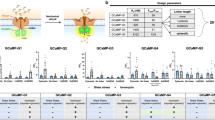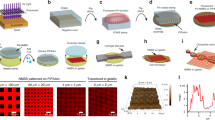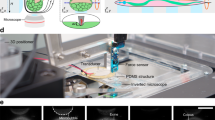Abstract
Methods for probing mechanical responses of mammalian cells to electrical excitations can improve our understanding of cellular physiology and function1,2,3. The electrical response of neuronal cells to applied voltages has been studied in detail4, but less is known about their mechanical response to electrical excitations. Studies using atomic force microscopes (AFMs) have shown that mammalian cells exhibit voltage-induced mechanical deflections at nanometre scales5,6, but AFM measurements can be invasive and difficult to multiplex. Here we show that mechanical deformations of neuronal cells in response to electrical excitations can be measured using piezoelectric PbZrxTi1-xO3 (PZT) nanoribbons, and we find that cells deflect by 1 nm when 120 mV is applied to the cell membrane. The measured cellular forces agree with a theoretical model in which depolarization caused by an applied voltage induces a change in membrane tension, which results in the cell altering its radius so that the pressure remains constant across the membrane5,7. We also transfer arrays of PZT nanoribbons onto a silicone elastomer and measure mechanical deformations on a cow lung that mimics respiration. The PZT nanoribbons offer a minimally invasive and scalable platform for electromechanical biosensing.
This is a preview of subscription content, access via your institution
Access options
Subscribe to this journal
Receive 12 print issues and online access
$259.00 per year
only $21.58 per issue
Buy this article
- Purchase on Springer Link
- Instant access to full article PDF
Prices may be subject to local taxes which are calculated during checkout





Similar content being viewed by others
References
Arlett, J. L., Myers, E. B. & Roukes, M. L. Comparative advantages of mechanical biosensors. Nature Nanotech. 6, 203–215 (2011).
Montell, D. J. Morphogenetic cell movements: diversity from modular mechanical properties. Science 322, 1502–1505 (2008).
Vaziri, A. & Gopinath, A. Cell and biomolecular mechanics in silico. Nature Mater. 7, 15–23 (2008).
Kim, D. H. et al. Dissolvable films of silk fibroin for ultrathin conformal bio-integrated electronics. Nature Mater. 9, 511–517 (2010).
Zhang, P. C., Keleshian, A. M. & Sachs, F. Voltage-induced membrane movement. Nature 413, 428–432 (2001).
Kim, G. H., Kosterin, P., Obaid, A. L. & Salzberg, B. M. A mechanical spike accompanies the action potential in mammalian nerve terminals. Biophys. J. 92, 3122–3129 (2007).
Lin, Y. & Freund, L. B. Forced detachment of a vesicle in adhesive contact with a substrate. Int. J. Solids Struct. 44, 1927–1938 (2007).
Matsuzaki, M., Honkura, N., Ellis-Davies, G. C. & Kasai, H. Structural basis of long-term potentiation in single dendritic spines. Nature 429, 761–766 (2004).
Zheng, J. et al. Tensile regulation of axonal elongation and initiation. J. Neurosci. 11, 1117–1125 (1991).
Hill, B. C., Schubert, E. D., Nokes, M. A. & Michelson, R. P. Laser interferometer measurement of changes in crayfish axon diameter concurrent with action potential. Science 196, 426–428 (1977).
Iwasa, K., Tasaki, I. & Gibbons, R. C. Swelling of nerve fibers associated with action potentials. Science 210, 338–339 (1980).
Terakawa, S. Changes in intracellular pressure in squid giant axons associated with production of action potentials. Biochem. Biophys. Res. Commun. 114, 1006–1010 (1983).
Todorov, A. T., Petrov, A. G. & Fendler, J. H. Flexoelectricity of charged and dipolar bilayer-lipid membranes studied by stroboscopic interferometry. Langmuir 10, 2344–2350 (1994).
Petrov, A. G., Miller, B. A., Hristova, K. & Usherwood, P. N. Flexoelectric effects in model and native membranes containing ion channels. Eur. Biophys. J. 22, 289–300 (1993).
Nonnenmann, S. S., Leaffer, O. D., Gallo, E. M., Coster, M. T. & Spanier, J. E. Finite curvature-mediated ferroelectricity. Nano Lett. 10, 542–546 (2010).
Breneman, K. D., Brownell, W. E. & Rabbitt, R. D. Hair cell bundles: flexoelectric motors of the inner ear. PLoS ONE 4, e5201 (2009).
Harland, B., Brownell, W. E., Spector, A. A. & Sun, S. X. Voltage-induced bending and electromechanical coupling in lipid bilayers. Phys. Rev. E 81, 031907 (2010).
Guck, J. et al. The optical stretcher: a novel laser tool to micromanipulate cells. Biophys. J. 81, 767–784 (2001).
Brownell, W. E., Qian, F. & Anvari, B. Cell membrane tethers generate mechanical force in response to electrical stimulation. Biophys. J. 99, 845–852 (2010).
Bausch, A. R., Ziemann, F., Boulbitch, A. A., Jacobson, K. & Sackmann, E. Local measurements of viscoelastic parameters of adherent cell surfaces by magnetic bead microrheometry. Biophys. J. 75, 2038–2049 (1998).
Fu, J. et al. Mechanical regulation of cell function with geometrically modulated elastomeric substrates. Nature Methods 7, 733–736 (2010).
Gopal, A. et al. Nano-opto-mechanical characterization of neuron membrane mechanics under cellular growth and differentiation. Biomed. Microdev. 10, 611–622 (2008).
Cohen-Karni, T., Qing, Q., Li, Q., Fang, Y. & Lieber, C. M. Graphene and nanowire transistors for cellular interfaces and electrical recording. Nano Lett. 10, 1098–1102 (2010).
Xie, C. et al. Noninvasive neuron pinning with nanopillar arrays. Nano Lett. 10, 4020–4024 (2010).
Hallstrom, W. et al. Fifteen-piconewton force detection from neural growth cones using nanowire arrays. Nano Lett. 10, 782–787 (2010).
Nguyen, T. D. et al. Wafer-scale nanopatterning and translation into high-performance piezoelectric nanowires. Nano Lett. 10, 4595–4599 (2010).
Qi, Y. et al. Piezoelectric ribbons printed onto rubber for flexible energy conversion. Nano Lett. 10, 524–528 (2010).
Xu, S., Hansen, B. J. & Wang, Z. L. Piezoelectric-nanowire-enabled power source for driving wireless microelectronics. Nature Commun. 1, 93 (2010).
Greene, L. A. & Tischler, A. S. Establishment of a noradrenergic clonal line of rat adrenal pheochromocytoma cells which respond to nerve growth-factor. Proc. Natl Acad. Sci. USA 73, 2424–2428 (1976).
Stauffer, E. K. & Ziegler, R. J. Loss of functional voltage-gated sodium channels in persistent mumps virus-infected PC12 cells. J. Gen. Virol. 70, 749–754 (1989).
Duval, F. F. C. et al. Characterisation of PZT thin film micro-actuators using a silicon micro-force sensor. Sens. Actuat. A 133, 35–44 (2007).
Mosbacher, J., Langer, M., Horber, J. K. & Sachs, F. Voltage-dependent membrane displacements measured by atomic force microscopy. J. Gen. Physiol. 111, 65–74 (1998).
Qi, Y. et al. Enhanced piezoelectricity and stretchability in energy harvesting devices fabricated from buckled PZT ribbons. Nano Lett. 11, 1331–1336 (2011).
Feng, X. et al. Stretchable ferroelectric nanoribbons with wavy configurations on elastomeric substrates. ACS Nano 5, 3326–3332 (2011).
Li, Z., Zhu, G., Yang, R., Wang, A. C. & Wang, Z. L. Muscle-driven in vivo nanogenerator. Adv. Mater. 22, 2534–2537 (2010).
Acknowledgements
The authors thank N. Verma and N. Yao for useful discussions and advice, and G. Poirier, S. Xu, T. Liu, N.T. Jafferis and X. Xu for their help with technical issues. The authors thank Lynn W. Enquist for contributing reagents. The authors acknowledge use of the PRISM Imaging and Analysis Center, which is supported by the NSF MRSEC Program via the Princeton Center for Complex Materials (no. DMR-0819860). T.K. was supported by a National Science Foundation Graduate Student Research Fellowship (DGE-0646086). P.K.P acknowledges support from the Army Research Office (no. W911NF-11-1-0494), and M.C.M. acknowledges support from the Defense Advanced Research Projects Agency (no. N66001-10-1-2012) and the Army Research Office (no. W911NF-11-1-0397).
Author information
Authors and Affiliations
Contributions
T.D.N., J.M.N. and M.C.M. devised the studies. T.D.N., N.D., J.M.N., M.J.B. and M.C.M. designed the experiments. T.D.N., N.D. and T.K. performed the experiments. P.K.P. developed the theoretical model. T.D.N., N.D., J.M.N., T.K., P.K.P., M.J.B. and M.C.M. wrote the paper.
Corresponding author
Ethics declarations
Competing interests
The authors declare no competing financial interests.
Supplementary information
Supplementary information
Supplementary information (PDF 1993 kb)
Supplementary movie
Supplementary movie (AVI 20538 kb)
Rights and permissions
About this article
Cite this article
Nguyen, T., Deshmukh, N., Nagarah, J. et al. Piezoelectric nanoribbons for monitoring cellular deformations. Nature Nanotech 7, 587–593 (2012). https://doi.org/10.1038/nnano.2012.112
Received:
Accepted:
Published:
Issue Date:
DOI: https://doi.org/10.1038/nnano.2012.112
This article is cited by
-
Green Fabrication of Freestanding Piezoceramic Films for Energy Harvesting and Virus Detection
Nano-Micro Letters (2023)
-
Numerical modeling and analysis of coaxial electrohydrodynamic jet printing
Scientific Reports (2022)
-
Three-dimensional piezoelectric polymer microsystems for vibrational energy harvesting, robotic interfaces and biomedical implants
Nature Electronics (2019)
-
Numerical simulation of coaxial electrohydrodynamic jet and printing nanoscale structures
Microsystem Technologies (2019)
-
Full-field interferometric imaging of propagating action potentials
Light: Science & Applications (2018)



